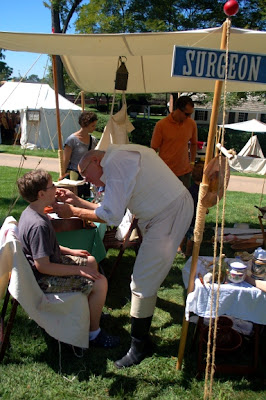In this vicinity on Aug. 5, 1812, six weeks after the outbreak of war, an Indian force, led by the famous Shawnee chief, Tecumseh, ambushed about 200 Americans under Major Thomas Van Horne who were on the way south to the River Raisin. There, supplies vitally needed by Hull's army in Detroit, were awaiting an escort through the Indian blockade of the River Road. Tecumseh opened fire as the Americans forded Brownstown Creek. Van Horne, overestimating the Indians' numbers, ordered his men to fall back. The retreat soon became a panic-stricken flight back to Fort Lernoult. Seventeen Americans were killed, 12 wounded, and two captured and murdered. One Indian was killed.The original monument for the Battle of Brownstown was dedicated in 1908 (it was rededicated in 2006).
There are a couple of odd inscriptions . . . one of which Dudeboy is pointing to. Look at the photo below for a close-up.
Obviously, not everyone thought highly of Tecumseh! This reminds me . . . there is a high school in Oklahoma called Tecumseh High School. And the name of their mascot? You guessed it, the Savages!
This result of this seemingly insignificant battle coupled with the Battle of Monguagon (fought just a few days later) was that Hull now believed that his supply lines were compromised. Which, of course, bolstered his decision to surrender Detroit. I daresay, the worst decision in the entire war.
If anyone asks you what was the end result of the War of 1812 . . . well, now you have your answer.
The marker for the Battle of Monguagon, or Maguaga (Trenton, Michigan) reads . . .
On August 9, 1812, a force of about 600 American troops, regulars and militia, moved down the River Road in an attempt to reach Frenchtown (Monroe) and bring back supplies needed desperately by the Americans in Detroit. At a point that cannot now be exactly located, near the Indian village of Monguagon, American scouts ran into a British and Indian force of about 400 hundred men, led by Capt. Adam Muir and Tecumseh, blocking the road south. Lieut. Col. James Miller quickly brought up his Americans and, in a running battle, drove the enemy back through present-day Trenton until the British pulled back across the river into Canada. Losses were heavy. Ironically, this the only battle won by the Americans in Michigan during the War of 1812, was followed a week later by Hull's surrender of Detroit.We spent the rest of the day at Greenfield Village. Of course, we timed our trip to coincide with the War of 1812 Muster at Greenfield Village in the Porches & Parlors Historic District of Greenfield Village.
We got to see the War of 1812 reenactors drill and parade. There were musket and cannon firings. And Dudeboy got to participate in a kids' recruitment and drill. He had a big time.
Dudeboy getting looked over by "ol' sawbones" to see if he is fit to volunteer.
The "raw" recruits . . .
On the way home we stopped by the Kentucky State Fair where there was a special exhibit called War Hawks & Valiant Volunteers: Kentuckians in the War of 1812. One of the items on display was this British drum taken by Kentuckians at the Battle of the Thames.
"Well, that was weird" exclaimed a teenage girl to her friends after the patriotic finale of the 30-minute musical BraveHunters of Kentucky! . . . Kentuckians in the War of 1812 put on by a local performing arts school at the Kentucky Sate Fair. "That was weird" . . . a perfect way to summarize not only the musical, but the war itself.















No comments:
Post a Comment